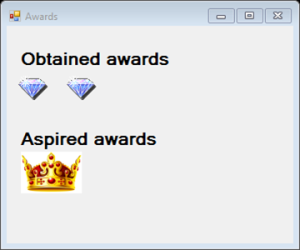Hi Nashwa,
Thanks for your comments on our previous post. I thought I’d start a new one, so we can easily share your screen-caps of work so far. (Just to recap, we’re using this blog as our dialogue in the spirit of sharing implicit in the Opposites Attract Challenge.)
Lets start with this one. The functionality on the top half is exactly what we talked about. I just need to think of some words that “gamify” it – turning it into an adventure rather than a form. It was easy coming up with the ideas visually in our previous thread, but when it come down to actually writing, making the story fit into the tiny number of words we have on the screen is a challenge in itself. We’ll return to this subject.
The lower half of the screen isn’t doing what I imagined when we last spoke. Or rather its DOING exactly as I imagined (excellent work on your part), but it doesn’t have the effect I imagined. Lets work it through…
We wanted to include the idea of time counting countdown, not to help the tutor plan their work, but rather to add a sense of jeopardy to the challenge. Correct me if I’m wrong, but because we decided to set the challenge as the completion of all the first four blocks on your original gameboard, these four different timers will always display the same number? I mean to say, the challenge is that the tutor has (in this case) seven days to complete the last task on the list. But s/he must complete the first three tasks before s/he can start that last one. So if indeed, it takes seven days to complete the first task (discover students’ learning preferences), then they will have run out of time to do the other three. So would it be better to have just one timer counting down and a checklist, something like this?
And I wonder whether it might be more fun to have the timer counting down days, hours, minutes, seconds and hundredths of a second (if that’s even possible in Visual) so that its changing all the time, giving an increased sense of urgency to the task. I also wonder if this lower half would work best as a window/page/tab of its own? (If it did, I imagine it would become the main screen when the app is being run.)
Each block of text could act as a button to take you to the activity, so for example when I click on “Discover Students’ Learning Prefs” it would take me to this screen:
This functions pretty much exactly as we discussed, but I have a couple of questions. What does the “Show Students’ VARK” button do? Does the validate need a button? I was hoping that, if the number of against each style didn’t total the number of students on the course the “Next block” (task? challenge?) button would be ghosted (or replaced with a message like “Get your students to complete the test and tell you their preference”) and it would only become operational when the total matched the number of students.
Next couple of screens. Does selecting a plan on this screen:
… lead to this screen?:
I thinking about what the app is asking the the tutor to input here. It’s offering links out to (in this case) services that might be useful, but what does the tutor have to do to say “Yes, I’ve completed my pedagogical planning!” We need to think a bit more about this.
I’m running out of time her before I need to pick up my boy from school, so two things. First of all, I like this screen:
But we need to settle of a fixed aspect ratio to build our screen designs into – at the moment, I think they are adapted to whatever we’ve asked them to do. And secondly, check out this link. My wife’s company is gamifying the selling of financial products, and here they are using a superhero narrative to give basic financial advice.























